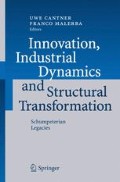Abstract
This paper aims to study, by means of a laboratory experiment and a simulation model, some of the mechanisms that dominate the phenomenon of knowledge diffusion in the process that is called ‘interactive learning’.We examine how knowledge spreads in different networks in which agents interact by word of mouth. We define a regular network, a randomly generated network and a small world network structured as graphs consisting of agents (vertices) and connections (edges), situated on a wrapped grid forming a lattice. The target of the paper is to identify the key factors that affect the speed and the distribution of knowledge diffusion. We will show how these factors can be classified as follows: (1) learning strategies adopted by heterogeneous agents; (2) network architecture within which the interaction takes place; (3) geographical distribution of agents and their relative initial levels of knowledge; (4) network size. We shall also attempt to single out the relative effect of each of the above factors.
Access this chapter
Tax calculation will be finalised at checkout
Purchases are for personal use only
Preview
Unable to display preview. Download preview PDF.
References
Acemoglu D, Angrist J (1999) How Large are the Social Returns to Education? Evidence from Compulsory Schooling Law. NBER, Working Paper
Akerlof G (1997) Social distance and social decisions. Econometrica, 65: 1005–1027
Ancori B, Bureth A, Cohendet P (2000) The economics of knowledge: The debate about codification and tacit knowledge. Ind Corp Change, 9,2: 255–287
Anderlini L, Ianni A (1996) Path dependence and learning from neighbours. Games Econ Behav, 13: 141–177
Bala V, Goyal S (1995) A theory of learning with heterogeneous agents. Int Econ Rev, 36,2: 303–323
Bala V, Goyal S (1998) Learning from neighbours. Rev Econ Stud, 65: 595–621
Bénabou R (1993) Working of a city: Location education and production. Quart J Econ, 58: 619–652
Berningaus S, Schwalbe U (1996) Evolution, interaction, and Nash equilibria. J Econ Behav Organ, 29: 57–85
Brock W, Durlauf S (1995) Discrete Choice with Social Interaction I: Theory. NBER Working Paper 5291
Chwe MSY (2000) Communication and coordination in social networks. Rev Econ Stud, 67: 1–16
Clark G (1984) Innovation Diffusion: Contemporary Geographical Approaches. Geo Books, Norwich
Cowan R, Jonard N (2004) Network structure and the diffusion of knowledge. J Econ Dynam Control, 28: 1557–1575
Dosi G, Marsili O, Orsenigo l, Salvatore R (1995) Technological regimes, selection and market structures. Small Bus Econ, 411–436
Durlauf S (1996) Neighborhood feedbacks, endogenous stratification, and income inequality. In: Barnett W, Gandolfo G, Hillinger C (eds.) Dynamic Disequilibrium Modelling, Cambridge University Press, Cambridge
Ellison G (1993) Learning, local interaction, and coordination. Econometrica, 61: 1047–1071
Ellison G (2000) Basins and attraction, long run stochastic ability and the speed of step-by-step evolution. Rev Econ Stud, 67: 17–45
Ellison G, Fudenberg D (1993) Rules of thumb of social learning. J Polit Economy, 101,4: 612–43
Ellison G, Fudenberg D (1995) Word-of-mouth communication and social learning. Quart J Econ, 110,1: 93–125
Glaeser EL, Sacerdote B, Scheinkman P (1996) Crime and social interactions. Quart J Econ, 111: 507–548
Goyal S (1996) Interaction structure and social change. J Inst Theoretical Econ, 152: 472–494
Jovanovic B, Rob R (1989) The growth and diffusion of knowledge. Rev Econ Stud, 56,198–9: 569–82
Morone P, Taylor R (2004) Small world dynamics and the process of knowledge diffusion. The case of the metropolitan area of greater Santiago De Chile. Journal of Artificial Societies and Social Simulation, 7,2
Morone P, Taylor R (2005) Learning dynamics with complex cognition. In: Pyka A, Hanusch H (eds.) Applied Evolutionary Economics and the Knowledge-based Economy, Edward Elgar, Cheltenham
Nelson R, Winter S (1982) An Evolutionary Theory of Economic Change. Harvard University Press
OECD (1996) Employment and Growth in the Knowledge-Based Economy. Paris
Pajares J, Hernández C, López A (2004) Agent-Based Modelling in Economics: Beyond the Neoclassical Paradigm. proceedings of the 2nd International Conference of the European Social Simulation Association, University of Valladolid-Spain, 16–19 September
Rauch J (1993) Productivity gains from geographic concentration of human capital: Evidence from the cities. J Urban Econ, 34: 380–400
Rogers EM (1995) Diffusion of Innovation. Free Press, New York, 4th edn.
Silverberg G, Dosi G, Orsenigo L (1988) Innovation, diversity and diffusion: A self-organization model. Econ J, 98: 1032–1054
Watts A (2001) A dynamic model of network formation. Games Econ Behav, 34: 331–341
Watts DJ (1999) Small Worlds. Princeton University Press, Princeton
Watts DJ, Strogatz S (1998) Collective dynamics of small-world networks. Nature, 393: 440–442
Author information
Authors and Affiliations
Editor information
Editors and Affiliations
Rights and permissions
Copyright information
© 2007 Springer-Verlag Berlin Heidelberg
About this chapter
Cite this chapter
Morone, A., Morone, P., Taylor, R. (2007). A laboratory experiment of knowledge diffusion dynamics. In: Cantner, U., Malerba, F. (eds) Innovation, Industrial Dynamics and Structural Transformation. Springer, Berlin, Heidelberg. https://doi.org/10.1007/978-3-540-49465-2_15
Download citation
DOI: https://doi.org/10.1007/978-3-540-49465-2_15
Publisher Name: Springer, Berlin, Heidelberg
Print ISBN: 978-3-540-49464-5
Online ISBN: 978-3-540-49465-2
eBook Packages: Business and EconomicsEconomics and Finance (R0)

